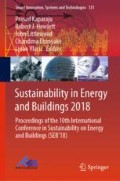Abstract
This work presents the feasibility of converting existing buildings to Net Zero Energy Buildings (NZEB), aiming to increase the integration of Renewable Energy Sources (RESs). Three buildings Office Building (N54), Engineering Laboratory (N44) and Residential Building (N24) are considered as the experimental candidates with different modes of operation. A baseline model N78, an operating NZEB is considered to calculate the energy budget of the candidate buildings. The energy budget provided the target to be achieved and the design variables to be considered. After the analysis of the integrated performance of the buildings, feasibility of the NZEBs was validated. The energy budget calculation done for the simulated results show that the integrating of the RESs in the buildings results in buildings N54 and N24 having higher feasibility and N44 lower feasibility for conversion to NZEB.
Access this chapter
Tax calculation will be finalised at checkout
Purchases are for personal use only
References
Leskarac, D., et al.: Testing facility for research and development of Smart-MicroGrid technologies. In: Power and Energy Engineering Conference (APPEEC), 2015 IEEE PES Asia-Pacific (2015)
Commercial Building Disclosure: A National Energy Efficiency Program, 16 May 2011 (2011). http://www.cbd.gov.au/
Torcellini, P., et al.: Zero energy buildings: a critical look at the definition. National Renewable Energy Laboratory and Department of Energy, US (2006)
Laustsen, J.: Energy efficiency requirements in building codes, energy efficiency policies for new buildings. In: International Energy Agency (IEA), pp. 477–488 (2008)
Robert, A., Kummert, M.: Designing net-zero energy buildings for the future climate, not for the past. Build. Environ. 55, 150–158 (2012)
Sartori, I., Napolitano, A., Voss, K.: Net zero energy buildings: a consistent definition framework. Energy Build. 48, 220–232 (2012)
Hernandez, P., Kenny, P.: From net energy to zero energy buildings: Defining life cycle zero energy buildings (LC-ZEB). Energy Build. 42(6), 815–821 (2010)
Kapsalaki, M., Leal, V.: Recent progress on net zero energy buildings. Adv. Build. Energy Res. 5(1), 129–162 (2011)
Erhorn, H., Erhorn-Kluttig, H.: Selected examples of Nearly Zero-Energy Buildings. Report of the Concerted Action EPBD (2014)
Aelenei, L., et al.: Design issues for net zero-energy buildings. Open House Int. 38(3), 7–14 (2013)
Bennett, C., et al.: Applicability of load forecasting techniques for customer energy storage control systems. In: Power and Energy Engineering Conference (APPEEC), 2015 IEEE PES Asia-Pacific (2015)
Brown, K., Energy Efficiency: Setting Enhanced Performance Targets for a New University Campus: Benchmarks vs. Energy Standards as a Reference? (2002)
Moghimi, M., et al.: Communication architecture and data acquisition for experimental MicroGrid installations. In: Power and Energy Engineering Conference (APPEEC), 2015 IEEE PES Asia-Pacific (2015)
Petersen, B., et al.: Integrating intelligent electric devices into Distributed Energy Resources in a cloud-based environment. IEEE (2013)
Author information
Authors and Affiliations
Corresponding author
Editor information
Editors and Affiliations
Rights and permissions
Copyright information
© 2019 Springer Nature Switzerland AG
About this paper
Cite this paper
Muthuraju, P., Moghimi, M., Stegen, S., Lu, J., Kaparaju, P. (2019). Integration of Renewable Energies to Convert University Commercial Buildings to Net-Zero Energy Buildings. In: Kaparaju, P., Howlett, R., Littlewood, J., Ekanyake, C., Vlacic, L. (eds) Sustainability in Energy and Buildings 2018. KES-SEB 2018. Smart Innovation, Systems and Technologies, vol 131. Springer, Cham. https://doi.org/10.1007/978-3-030-04293-6_10
Download citation
DOI: https://doi.org/10.1007/978-3-030-04293-6_10
Published:
Publisher Name: Springer, Cham
Print ISBN: 978-3-030-04292-9
Online ISBN: 978-3-030-04293-6
eBook Packages: Intelligent Technologies and RoboticsIntelligent Technologies and Robotics (R0)

